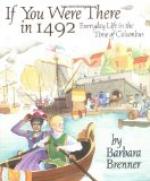The admiral’s reasoning about the continent.
The discovery of the continent of America by Columbus, in his third voyage, was the result of a distinct intention on his part to discover some new land, and cannot be attributed to chance. It would be difficult to define precisely the train of ideas which led Columbus to this discovery. The Portuguese navigations were one compelling cause. Then the change, already alluded to, which Columbus had noticed in his voyages to the Indies, on passing a line a hundred leagues west of the Azores, was in his mind, as it was in reality, a circumstance of great moment[21] and significance. It was not a change of temperature alone that he noticed, but a change in the heavens, the air, the sea, and the magnetic current.
[Footnote 21: It is the opinion of Humboldt, as mentioned before, that the celebrated division, made by Alexander the Sixth between the Castilian and Portuguese monarchs, was adopted in reference to these phenomena which Columbus had noticed: and, if the line of no variation were a “constant,” no better marine boundary could well be suggested.]
In the first place, the needles of the compass, instead of north-easting, north-wested at this line; and that remarkable phenomenon occurred just upon the passage of the line, as if, Columbus says, one passed a hill. Then, the sea there was full of sea-weed like small pine-branches, laden with a fruit similar to pistachio nuts. Moreover, on passing this imaginary line, the admiral had invariably found that the temperature became agreeable, and the sea calm. Accordingly, in the course of this voyage, when they were suffering from that great heat which has been mentioned, he determined to take a westerly course, which led, as we have seen, to his discovering the beautiful land of Paria.[22]
[Footnote 22: Las Casas, who had other authentic information about this voyage besides the manuscripts of Columbus, says, that the admiral intended to have gone southwards, after he had taken a westerly course, on quitting the place where he was becalmed. Had he done so, which the state of his ships would not permit, he might have been the discoverer of Brazil.]
Peculiar theory of the shape of the earth.




